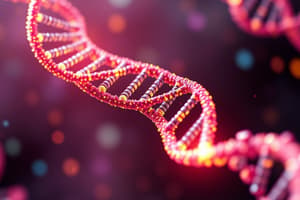Podcast
Questions and Answers
What is the primary purpose of a DNA microarray?
What is the primary purpose of a DNA microarray?
- To measure the size of DNA molecules
- To produce gene knockout collections
- To monitor the expression of thousands of genes simultaneously (correct)
- To sequence entire genomes
The laser scanner used for DNA microarrays provides lower resolution images than conventional optical microscopes.
The laser scanner used for DNA microarrays provides lower resolution images than conventional optical microscopes.
False (B)
What happens to the DNA microarray after it is washed with a buffer?
What happens to the DNA microarray after it is washed with a buffer?
Unbound cDNAs are removed.
A DNA microarray is also known as a _________.
A DNA microarray is also known as a _________.
Match the following concepts with their descriptions:
Match the following concepts with their descriptions:
What is the typical length of oligonucleotides used in DNA microarrays?
What is the typical length of oligonucleotides used in DNA microarrays?
DNA microarrays can only analyze one gene at a time.
DNA microarrays can only analyze one gene at a time.
What is the purpose of using fluorescently labeled cDNA in RNA sequencing?
What is the purpose of using fluorescently labeled cDNA in RNA sequencing?
The process of creating cDNA from mRNAs involves the use of _____ and reverse transcriptase.
The process of creating cDNA from mRNAs involves the use of _____ and reverse transcriptase.
Match the following terms related to functional genomics with their definitions:
Match the following terms related to functional genomics with their definitions:
Flashcards
DNA microarray
DNA microarray
A small, solid surface dotted with many DNA sequences, each representing a specific gene, used to measure gene expression levels.
cDNA synthesis
cDNA synthesis
The process of converting RNA into DNA, necessary for analyzing gene expression using DNA microarrays.
Hybridization
Hybridization
When complementary DNA sequences bind to each other on a DNA microarray, indicating the gene is being expressed.
Fluorescence intensity
Fluorescence intensity
Signup and view all the flashcards
Laser scanner
Laser scanner
Signup and view all the flashcards
What is a DNA microarray?
What is a DNA microarray?
Signup and view all the flashcards
What is the structure of a DNA microarray?
What is the structure of a DNA microarray?
Signup and view all the flashcards
How does a DNA microarray work?
How does a DNA microarray work?
Signup and view all the flashcards
What is a gene knockout?
What is a gene knockout?
Signup and view all the flashcards
Why are gene knockouts useful?
Why are gene knockouts useful?
Signup and view all the flashcards
Study Notes
Functional Genomics
- Functional genomics aims to understand the roles of genetic sequences (DNA and RNA) within a species.
- Researchers study genes in large groups to analyze their interactions in metabolic pathways.
- This research describes how gene products interact for cellular processes.
Proteomics
- Proteomics is the study of the entire protein collection (proteome) of a cell or organism.
- Scientists aim to understand the functions and interactions of proteins.
- The goal is to determine the traits of a species.
- Proteomics involves experimental and computational approaches.
Bioinformatics
- Bioinformatics uses computers, mathematical tools, and statistics to analyze biological information.
- This field examines genetic data (e.g., DNA sequences) and other biological information.
- Bioinformatics plays a crucial role in functional genomics and proteomics.
DNA Microarrays
- DNA microarrays, also called gene chips, quantify gene expression in thousands of genes concurrently.
- A small slide holds thousands of DNA sequences corresponding to different genes.
- Using fluorescently labeled cDNA, the amount of a gene's transcription can be measured.
- High fluorescence intensity signifies a large mRNA presence linked to that specific DNA spot.
RNA Sequencing (RNA-Seq)
- RNA-Seq is a newer transcriptome analysis method using next-generation sequencing.
- It sequences cDNA produced from RNA to identify specific RNAs and their concentrations.
- RNA-Seq compares transcriptomes across different cell types, disease states, or environmental conditions.
Gene Knockout Collections
- Gene knockout collections are useful in determining gene functions.
- Researchers inactivate individual genes one at a time to observe the resulting phenotypes.
- This approach aids in understanding cellular pathways and complex traits associated with genes.
- Transposable elements and CRISPR-Cas technology are used for gene knockout collections.
Two-Dimensional Gel Electrophoresis (2-DE)
- 2-DE is a protein separation technique.
- Separates proteins in a gel based on isoelectric point (charge) and molecular mass.
- Identifies and isolates thousands of different proteins within a single sample.
Mass Spectrometry
- Mass spectrometry precisely determines molecule masses, including fragments of proteins.
- Tandem mass spectrometry sequences peptides to identify whole proteins.
- Used to identify proteins from 2-DE spots and further study protein covalent modifications.
Protein Microarrays
- Protein microarrays provide a platform for examining protein expression and function.
- Using tiny spots of purified proteins from a cell, researchers can analyze protein-ligand interactions (e.g., drug interactions).
- Antibody microarrays and functional protein arrays are two types.
Bioinformatics I: Overview of Computer Analyses and Gene Prediction
- Bioinformatics integrates computer science, mathematics and statistics to analyze biological data (e.g. sequences).
- Sequences are stored in computer data files which are then analyzed by computer programs.
- Sequence recognition, pattern recognition and sequence element (motif) identification are computational strategies used in sequence analysis.
- Gene prediction identifies protein-coding DNA segments.
- Computational tools identify sequences of particular meaning or function.
Bioinformatics II: Databases
- Databases are organized collections of biological data like DNA, RNA and protein sequences.
- These databases store genetic sequences, additional information (annotations) and references.
- Examples include GenBank, EMBL and DDBJ (nucleotide sequences), UniProt, SwissProt, and PIR (amino acid sequences).
- Clinical databases, such as OMIM and ClinVar provide crucial genetic information related to human diseases.
Bioinformatics III: Homology
- Homology refers to similarities in organisms or molecules due to shared ancestry.
- Homologous genes are derivates of a common ancestral gene.
- Orthologs serve the same function in different species, whereas paralogs carry out different functions in the same species.
- Computer programs, such as BLAST, identify similar sequences from a database search which can help predict gene function.
- Multiple sequence alignment compares homologous sequences to find conserved sites which may be functionally important.
Studying That Suits You
Use AI to generate personalized quizzes and flashcards to suit your learning preferences.




